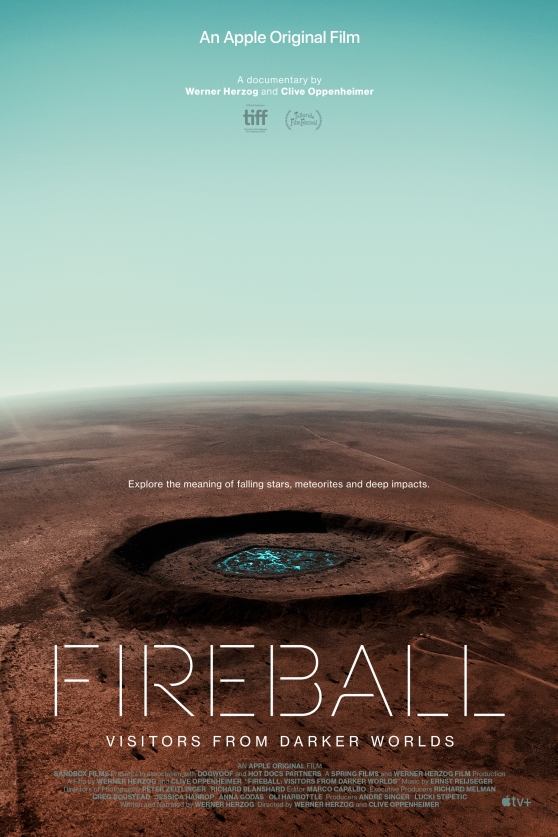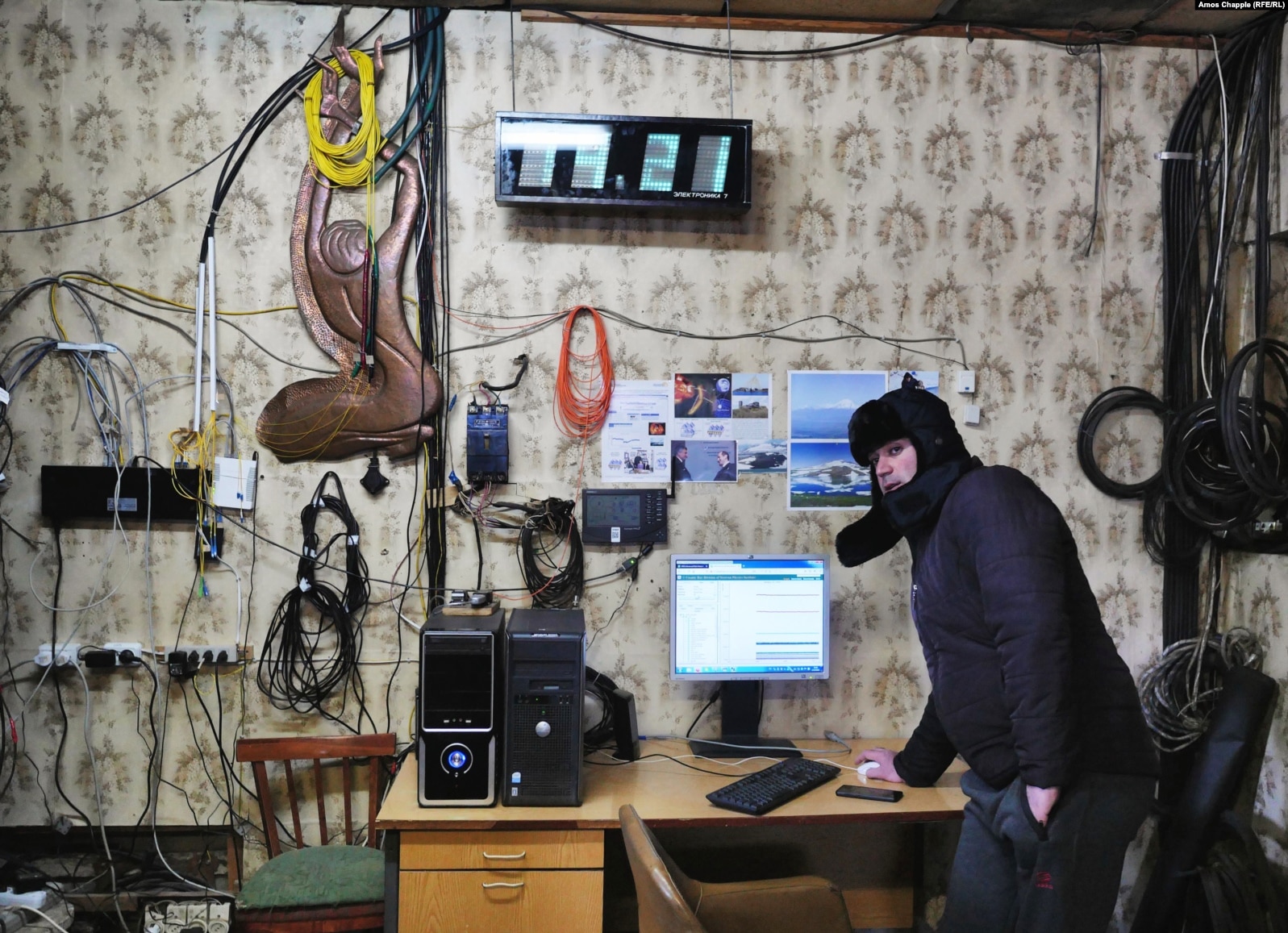Fireball: Visitors from Darker Worlds is a 2020 documentary film directed by Werner Herzog and Clive Oppenheimer. The film explores the cultural, spiritual, and scientific impact of meteorites, and the craters they create around the globe. (wiki)

Fireball: Visitors from Darker Worlds is a 2020 documentary film directed by Werner Herzog and Clive Oppenheimer. The film explores the cultural, spiritual, and scientific impact of meteorites, and the craters they create around the globe. (wiki)

timespace coordinates: somewhere in the East Germany 1960s 1970s 1980s
Somehow I cannot embed the link so here it is (sadly only in German! and only available till 11.05.2022 ∙ 23:59). Many thanks to Julia Linda Schulze for catching on with this documentary and keeping us in the loop with it!
//This is, without question, one of the best documentaries I have seen about the context, ideals and cinematography surrounding East bloc, ex-Socialist SF. Maybe this is again a demonstration as why it is such a niche thing and why most of the older SF movies do not getting enough of an exposure and why it is easy to get stuck with images of mostly US, English-language movies from the same period (mainly space-age 1960s and 1970s). There is lots of interviewed researchers including film directors, special effects contributors, script writers, set designers, costume makers as well as SF historians, SF writers, art curators etc from current Germany that dwell on the retro-futuristic, the ideological engagements of the DDR period and the general openness towards a better and definitely more Internationalist and Pacifist, non-militarist future. The usual triumphalist scientist vision of unlimited growth and untrammeled progress that hounded so much of the Soviet planning is not really prominent, there is more questions and warnings as well as usual problems carried along in space. A few ideas first of what struck me when watching it. If you want to know more and see a few screen captures I made, here’s my take on it with the TW thread like rabbit hole into various related directions.//
Cosmonaut in the front is played by legendary Serbian actor Gojko Mitic that is known as the East German Winnetou in the Karl May Easterns (Ostern), as well as for his cosmonaut in 1970 DEFA studios Signale – Ein Weltraumabenteuer (Signals: A Space Adventure):
Black Hole Survival Guide by Janna Levin
My rating: 5 of 5 stars
Black Hole Survival Guide – is probably top ten of Survival Guides in the Universe (even better than The Zombie Survival Guide: Recorded Attack; Downtown LA). Can one pull trough the math behind the existence of black holes and still come out sane on the other side? Well, if math is not your strength but you’re still willing to grapple with inherent complexities in a readable form and enticing style, this is your entry. Even without the tongue-in-a-cheek survivalist or prepper add-on, it is still a remarkable book about the most extreme objects in the universe.
I truly appreciate an author taking time to take us along, to cognitively estrange us from everything we thought we knew about the tangible universe, and funnel us towards things that lie beyond any type of immediate perception or empirical experience. No wonder, since time itself begins to comport weirdly around them. Benjamin Bratton wrote in his intro to The Terraforming about the impact of the “The Black Hole”(of M87*) picture, and where this representation stands in a lineage of astronomic imaging. Blue Marble or Earthrise images are still images of the Earth, still operative, still clinging to the geocentric iconicity that props up “transitional humanisms” of an unfinished Copernican Turn. The Black Hole image is frightening because it resists mirroring back, and in a way this non-operative image makes our planet turn into a camera that is not looking “up” or “in” but “out”. The hyperdense void enclosed by the Event Horizon is frightening, and not just because it “uproots the human” as in Heidegger’s angsty 1966 interview in Der Spiegel. Once the certitude of extinction seeps in and uprootedness is taken as a given, there is room to move on. This “something” that is a crushing time-space nothingness- makes us care here on Earth for an impossibly remote invisible object (its light arriving from the Eocene to us) at odds with every other single phenomenon we encounter in our earthly life.
Black holes have become huge imaginary and cultural attractants in SF, movies, books, artwork, philosophy, etc At the same time, even when dealing with black holes – cosmic or bodily, I agree that we should beware of male authors or artists making claims about emptiness since as Audrey Wollen’s beloved meme keeps remind us that ‘Girls own the void’.
How is it that we start to care about something so remote from everything that we know or care about?! Janna Levin guides us patiently, step by step towards this all-engulfing event horizon & even towards what might lie beyond it. This travelogue puts any other travel (cheap flight or X spaceship included) to shame. It is a rendezvous with an astronomical feature that we never think as – tangible, as touchable, and that will always keep being doggedly theoretical. It was a theoretical object not so long ago. Janna Levin makes the impossible happen – an embodied experience of what it would be like to go down the drain of a black hole, in fact, several such black holes. Another important inescapable fact is that black holes have the same status as elementary particles, and this is definitely hard to grasp. No matter how big, they are all equal in a way that all atoms of the same kind are equal.
Yes, we think we know about trees falling in the pre-human forest without our minds realizing or sensing it, but what about a non-sensuous perception of objects whose ‘nothingness’ shapes the largest galactic structures, giving a twist to everything, even our spiral galactic core.
This delightful book makes Janna Levin stands tall on my list of fav STEM outreach examples. The book works for all age groups and even has some great illustrations to make her point. Exposing us to remote larger-than-life forces, she managed to pull me beyond a reality of terrestrial lockdown and uncertain futures. Scientists or authors with a background in life sciences writing sci-fi (i am thinking here of Peter Watts, Adrian Tschaikowsky, Chris Beckett or the great Joan SLONCZEWSKI!) have a special spot in my heart. I live for (and love) speculative fiction – yet I still recognize that without Kip Thorne’s contribution to Christopher Nolan’s filmic oeuvre the CGI-digitally designed black hole Accretion Disk in Interstellar might have felt quite anodyne, maybe less appetizing and less aesthetically entrancing and tangible.
So I think that black holes via Black Hole Survival Guide – will definitely become more accessible to non-specialists in a way that is not dumbing down nor patronizing, attractive in the most literal sense of the term. Ominous and good to speculate (get comfy?) with, the STEM scientist/physicist/astronomer by training makes a good friend to have along on a deep dark cosmic journey. I could not pinpoint what are the new “rules of the game” that Janna Levine brings or if there is any magic secret to this scientific imaginary (i want to believe that imagination pools and informs both rigorously scientific and non-scientific speculative endeavors). From that special skillset, if I can single out one- is the ability to sum up the current state of knowledge on a given topic. What are the implication of black holes, unthinkable (for us) implications((for now) not just on stars but carbon-based bodies and minds such as ours, seemingly prisoners of our isolated sensorium and our speck of the universe?
I appreciate her own subjective-objective intervention – the informed ability to lean on other available explanations, or limit or circumscribe explanations while reaching out for other theoretically sound possibilities.
This I find vital. There is of course and the silliness and the sound advice one gets (how to choose which black holes to fall into! answer: the larger the better) along the way. As remote as it sounds – you can play around in your head with monstrous black hole peculiarities that seem to multiply. As we get closer to these cosmic sublime objects we seem to get a taste of infinities. As we taste some of the limits of science when approaching or entering a black hole we look beyond. To be able to hold on to this you need to envision the precise moment when you start seeing the back of your head (truly) and Janna Levin brings us as close to that as currently possible.
View all my reviews
Children of the Sea (Japanese: 海獣の子供, Hepburn: Kaijū no Kodomo) is a 2019 Japanese animated film directed by Ayumu Watanabe and produced by Eiko Tanaka, with animation production by Studio 4°C. It is based on the manga of the same title by Daisuke Igarashi, who also wrote the film’s screenplay.
It is Watanabe’s first theatrically released film since Space Brothers #0 (2014), and the first animated film adaptation of an Igarashi manga. The film stars the voices of Mana Ashida, Hiiro Ishibashi and Seishū Uragami. Set by and in the ocean and themed on the mysteries of life, it depicts the connections between humanity and nature. (wiki)
The “kaiju” in the Japanese title is the Japanese term for a marine mammal (“sea beast”), but is written with Japanese characters that mean literally “strange beast” (referring to monsters like Gojira (1954) and/or Mosura (1961)).

Byurakan Astrophysical Observatory official
Viktor Ambartsumian Armenian-Soviet scientist founder of the Byurakan Observatory
Synopsis Mount Aragaz is the highest mountain in Armenia. At an altitude of 3500 m one can find the remnants of a prestige project of the Soviet Union: the weather beaten buildings of Aragats Cosmic Ray Division. Here, more than a hundred men used to search for messengers from distant galaxies – particles, created by cosmic radiation on its way to earth in billions of tiny explosions. Most of the researchers left, when the financial support of the institution collapsed with the Soviet Union. However, despite the lack of funding a small group of Armenian scientists endures on the top of Mount Aragaz. Like astronauts in a spaceship they continue their research, hoping for a sensation: The discovery of unknown galaxies.
Statement
The Universe, the Nothingness, the Solitude – three scientists are holding out at what was once the Soviet Union’s greatest cosmic research station. Are they closer to the secret of Creation – here, on top of Armenia’s highest mountain? In their work they rather look like Sisyphus’ brothers, and it is not by accident that they start searching for the meaning of their existence, of God’s existence. Man asks, and the World does not reply. Or does it?
DURATION: 30 min
FORMAT: 35 mm / Farbe / 1:1,85 / DolbySR
LANGUAGE: armenian / german and english subtitles (optional)
PRODUCTION: Pelle Film in Ko-Produktion mit der HFF München und dem Bayerischen Rundfunk
Armenia’s Cosmic-Ray Catchers 2020 article
‘We’re Above Civilization’: life in a cosmic-ray station photo essay






<<974

PG: Psycho Goreman, or simply Psycho Goreman, is a 2020 Canadian science-fiction horror comedy film written and directed by Steven Kostanski (Astron-6). It stars Nita-Josee Hanna and Owen Myre as a young sister and brother who unwittingly resurrect an ancient extraterrestrial overlord (played by Matthew Ninaber). (wiki)

Having been acquired by RLJE Films and Shudder, Psycho Goreman is scheduled to be released in theaters and on video on demand on January 22, 2021.
The Muslim world is not commonly associated with science fiction. Religion and repression have often been blamed for a perceived lack of creativity, imagination and future-oriented thought. However, even the most authoritarian Muslim-majority countries have produced highly imaginative accounts on one of the frontiers of knowledge: astrobiology, or the study of life in the universe.
This book argues that the Islamic tradition has been generally supportive of conceptions of extra-terrestrial life, and in this engaging account, Jörg Matthias Determann provides a survey of Arabic, Bengali, Malay, Persian, Turkish, and Urdu texts and films, to show how scientists and artists in and from Muslim-majority countries have been at the forefront of the exciting search. Determann takes us to little-known dimensions of Muslim culture and religion, such as wildly popular adaptations of Star Wars and mysterious movements centred on UFOs. Repression is shown to have helped science fiction more than hurt it, with censorship encouraging authors to disguise criticism of contemporary politics by setting plots in future times and on distant planets. The book will be insightful for anyone looking to explore the science, culture and politics of the Muslim world and asks what the discovery of extra-terrestrial life would mean for one of the greatest faiths.
Jörg Matthias Determann TW / academia.edu